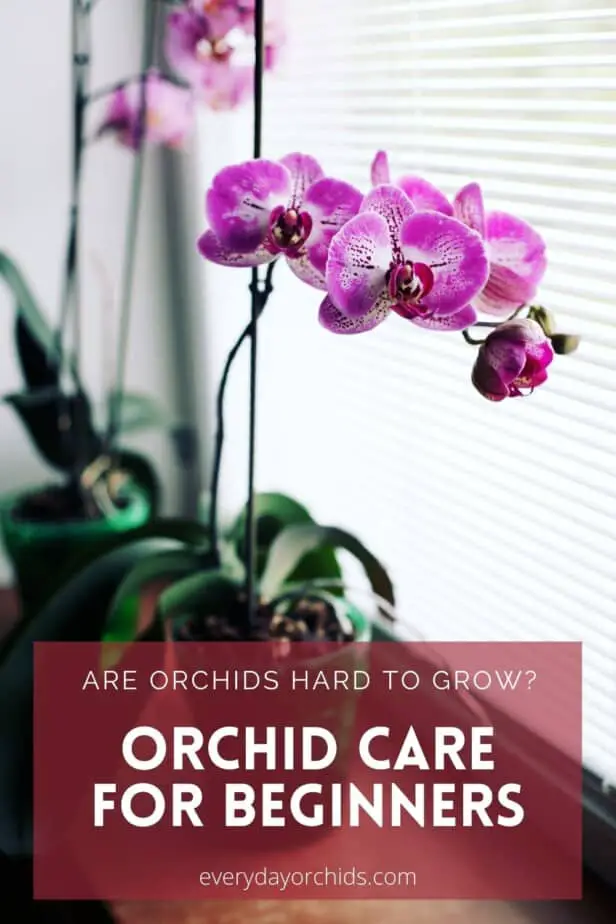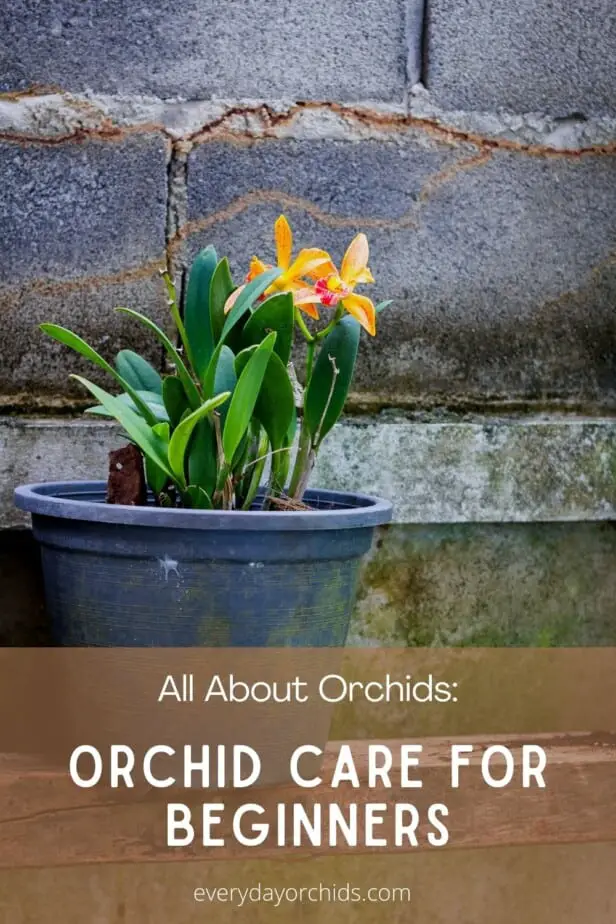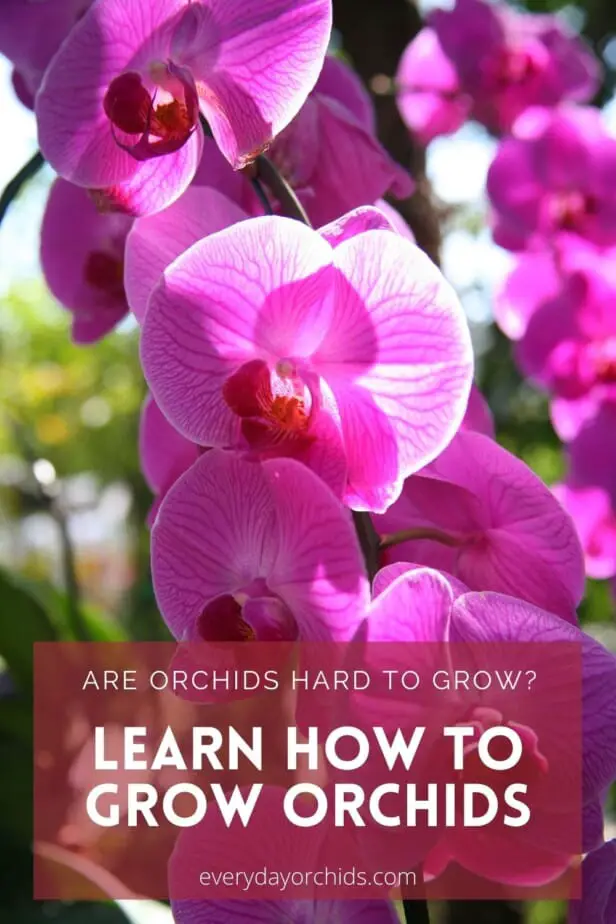Are you wondering if orchids are hard to grow? Although a little intimidating to some, orchids are not hard to grow. These beautiful houseplants that can come in various colors and shapes. In fact, there are over 30,000 known species of orchids, some of which can be grown in your own home.
Orchids have specific maintenance requirements, which can be challenging for novice gardeners. However, if the proper steps are followed, growing orchids is not very difficult. In fact, it can be a rewarding and gratifying experience.

The rest of this article will explain the different types of orchids and their growing requirements. I will also give you some maintenance tips for growing healthy orchids and some fun information about orchids. Keep reading to learn more.
Please note that these links are affiliate links and as an Amazon Associate, I earn from qualifying purchases. Purchases made through affiliate links in this post may generate commissions at no additional cost to you. Use this link for a discounted Amazon Prime trial. Thank you for your support!
Table of Contents
Which Orchids Are the Easiest Or Hardest To Grow?

The needs of orchids vary from species to species, like all plants. As such, it is important to research what the requirements of a plant are in order to know if you can care for them.
Lighting, temperature, and humidity are all critical aspects of basic orchid care. You will need to know the tolerance of your orchid species and how sensitive it is to changes in the environment.
Basic Orchid Information
Orchids can naturally be found in tropical locations, such as Central and South America and Asia. In North America, almost all orchids are kept indoors, whether in homes as houseplants or in greenhouses. There are three main types of orchids:
- Most tropical orchids are epiphytic, which means that they grow in the air. This type of orchid requires a growing medium that provides good aeration and drainage.
- Terrestrial, which means that this type of orchid grows in the ground. Pseudobulbs or roots anchor these orchids to the ground. Some even require a frost event to initiate blooming.
- Lithophytic orchids grow on rocks or rock faces. These orchids include the Paphiopedilum, or Lady Slipper, species.
You can recognize orchids by their characteristic petals. One of the petals protrudes and there are three sepals and three additional petals.
The reason for the huge variety of blooms can be attributed to the different pollinators for each species of orchid. Insects that commonly cross-pollinate orchids are bees, wasps, and flies. Some orchids have even evolved to attract birds and butterflies.
Characteristics of Easy and Difficult Orchids
All orchids require a specific amount of attention and maintenance. However, some can be more sensitive than others and require extra time, energy, or money to care for. Additionally, some orchids may require special equipment like heat lamps or humidifiers.
If you are new to growing orchids, it is best to start with ones that are easy to grow before trying to care for a more challenging species.
Many Orchids Are Easy To Grow
They may be intimidating at first, but the majority of orchids do not require special conditions or fancy equipment. Some require a similar level of effort as to other houseplants, in terms of routine watering and feeding schedules. Those that are easiest to grow would have the following attributes:
- Readily available and relatively inexpensive
- Thrive in houses at room temperature
- Do not require special equipment
Recommended for beginners, the easiest orchids to grow would be a Phalaenopsis (“Moth Orchid”) and a Cattleya (“Classic Orchid”).
Challenging Orchids Can Be Rewarding
Many plant enthusiasts rise to the challenge of growing difficult orchids, with their eventual goal to have them bloom. This requires patience and time, but the results can be gratifying. The following are all features of “demanding” orchids that should be considered:
- Additional equipment may be needed, like heat lamps
- Very sensitive to changes in heat or temperature
- Difficult to source, not easily available or expensive
Based on their watering and temperature needs, two examples of challenging orchids would be a Paphiopedilum (“Lady’s Slipper”) or Oncidium (“Dancing Lady”) orchid.
What Are Some Good Orchids for Beginners?

For beginners, orchids that are not overly sensitive to light, water, or food are best. It’s also beneficial if the plant is inexpensive and fairly common. That way, there are many resources available in case you have questions or concerns.
Some orchids demand a lot of patience and attention to grow. If you are new to orchid growing, you should avoid these high-maintenance orchids.
Phalaenopsis Orchids
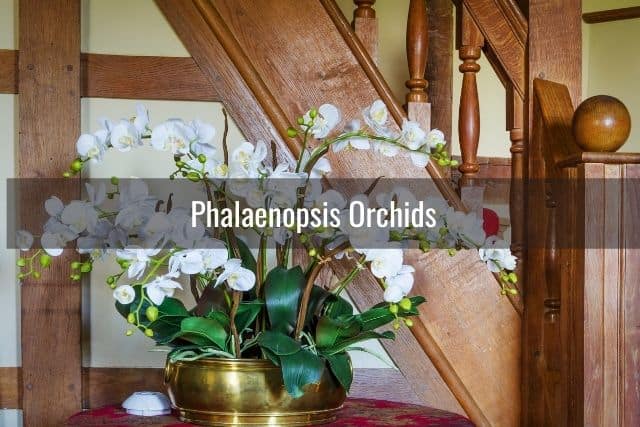
Phalaenopsis is commonly referred to as the “moth orchid.” This is a great option for those just starting to care for orchids.
You can find Phalaenopsis orchids at grocery markets or department stores. Additionally, moth orchids are among the more common plant species available to purchase online from various sources.
A Phalaenopsis orchid is popular for many reasons:
- This orchid comes in various colors and patterns, including white, pink, red, spotted, and striped.
- Blooms last 3 to 6 weeks. Phalaenopsis orchids in bloom are readily available to purchase.
- Due to their light and temperature needs, Phalaenopsis orchids do well in a majority of households.
- You can repot these orchids at anytime. However, it’s best to do so when the plant isn’t in bloom.
Cattleya, the “Classic Orchid”
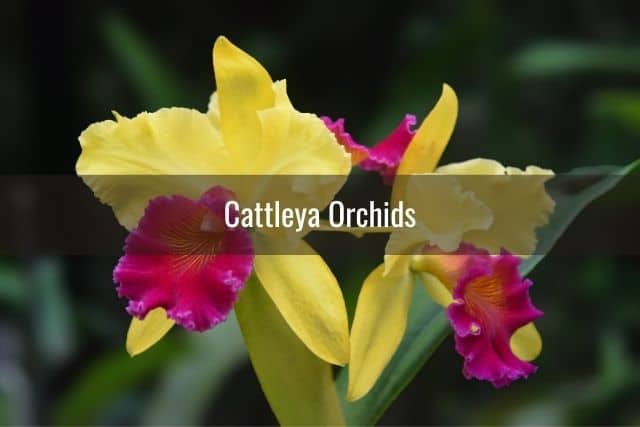
Common in bouquets and corsages, the Cattleya are beautiful orchids that are perfect for beginners.
In the summer, this species of orchid can be moved outside. Just make sure you water them properly and don’t let them get dehydrated. They do well in temperatures around 70℉ (approximately 21℃), which is normally what households set their thermostats to.
The Cattleya orchid is also a good choice for beginners:
- Like other orchids, they do well in bright, indirect light. They require approximately 5 to 6 hours of light each day.
- These orchids are low maintenance, needing a weekly watering in addition to feeding.
- Cattleya blossoms are scented and have beautiful ruffles. This has helped make them popular.
Are Orchids Hard To Grow And Keep Alive?
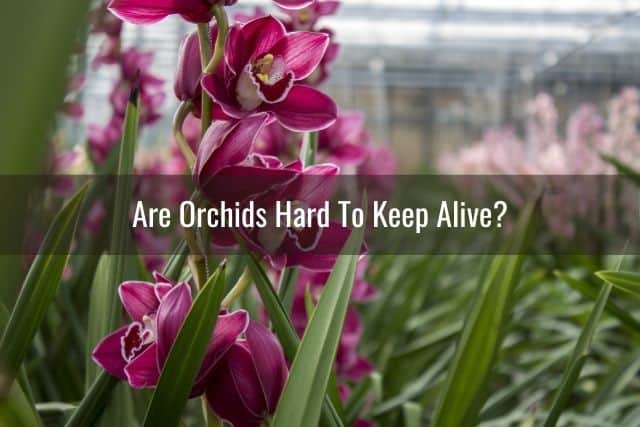
Like all plants, it is important to research the care and maintenance of your orchid species.
Compared to other low maintenance plants like the snake plant, which can tolerate low light and sporadic watering, orchids are more demanding. They do not do well with sudden changes in temperature and lighting. In addition, orchids are prone to root rot issues.
However, if you take the time to learn about your orchid plant’s basic requirements, they can be a great addition to your houseplant collection.
Learning the Basics of Orchid Care
Unless you have purchased a faux orchid, you will need to do some basic care for any species that you require. Of course, you already know this.
Orchid maintenance varies by species, but it is not hard to figure out what it takes to make them happy. There are many resources available. Additionally, if you are buying your orchid from a greenhouse or nursery, they will be glad to answer any questions that you may have.
How To Determine Lighting
All orchids have specific lighting requirements, including bright, indirect, and low to moderate light. A bright light could be provided by any window that receives at least 12-14 hours of full light, typically those facing south or west.
Indirect light and low light could be from windows facing east. Shaded windows that do not receive direct sunlight could also provide indirect or low light for your orchid.
Seasons are also important in affecting the amount of light that your orchids receive.
For example, in winter, many rooms in your home could be providing low light and you may need to supplement this light with artificial lighting. Alternatively, you could move your orchids to a different location or closer to the window.
In the summer, these same windows could provide bright light. You may need to move your orchids further away from the window. Additionally, trees or bushes that shade your windows could affect the quality of light reaching your plants.
How To Properly Water Orchids
As a general rule, it is better to water your orchid too little rather than too much. Too much water can lead to issues with the health of the plant, such as root rot.
Many factors influence when and how much to water your orchid, including the temperature, humidity, potting media, and airflow. Additionally, the plant species may help determine how much water it may need and the best method to do so.
Many of those that have experience growing orchids dunk the entire plant into a bucket or partially full sink. For a more traditional method, a watering can may also be a good option. Take care not to over-water or let water settle into the crown of the orchid, as this can lead to root rot and crown rot, respectively.
Humidity Is Important for Orchids
For all orchid species, humidity is an important factor to consider when taking care of your plants. For example, a Phalaenopsis orchid requires 40 to 70% humidity. An Oncidium orchid, which is much more sensitive, requires 50 to 60% humidity. Use a humidifier to reach your desired humidity level. Otherwise, use a mister to add humidity.
Another way to provide humidity to your orchids is through a humidity tray. Many do-it-yourself humidity trays are filled with small pebbles. These trays allow water to drain from the plant pots and collect around the pebbles. Then, the water in the humidity tray can evaporate and provide the plants sitting on top with some additional humidity.
If you are interested in learning more, check out this article on five easy ways you can provide humidity for your orchids.
How To Research Orchid Care and Maintenance
Due to their popularity, there is a lot of information out there for anyone interested in orchids, whether they are just beginners or are experienced growers. There are videos, online forums, and blogs dedicated to orchids, in addition to numerous books.
In fact, the American Orchid Society was founded in 1921 for those passionate about the plant. This society is a great resource for those who want to connect and share information with other like-minded individuals.
Potential Orchid Diseases and Pests
Orchids do not generally have diseases, but it is easy to recognize if something is wrong based on their roots or leaves’ appearance. Root rot and crown rot are both due to over or improper watering.
This can be avoided with proper drainage and knowing the orchid species’ care requirements. Leaf spot is evident by circular marks on the foliage. It can be treated by simply removing unhealthy plant tissue.
Like all houseplants, pests may find their way to their orchid and lead to various issues. Some common types of harmful insects include:
- Snails/slugs
- Mealybugs
- Thrips
- Spider mites
- Scale
- Aphids
- Mealybugs
- Fungus gnats
To learn about additional types of pests and how to treat them, check out this guide to orchid pests.
If your orchid shows signs of pests or diseases, try an approach without chemicals first. This can include the following treatment options:
- Administering neem oil, or other superior horticultural oils, as a foliar spray. If you are not familiar with neem oil, check out this article about using neem oil on orchids.
- Applying isopropyl alcohol with a Q-tip.
- Using insecticidal soap and warm water. This is recommended specifically for spider mites.
Although it is ideal to use an organic or non-chemical approach, this may not be effective or efficient in all cases. If your pest situation is getting out of hand, I would recommend Bonide Systemic Houseplant Insect Control. This product is advertised to have no mess, smell, or spray.
Where Is the Best Place in the House To Grow Orchids?
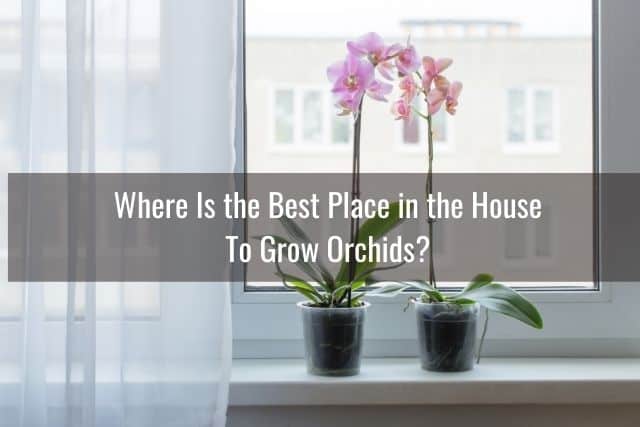
A good location for your orchid can be determined by the lighting, humidity, and temperature. These factors can vary depending on where you put your plants in your homes, such as if it is in front of a window or on your coffee table. Additionally, if you have children or pets, place your plant in an area where your orchid would not be accidentally knocked over.
Lighting Requirements of Orchids
It is difficult to tell if an orchid is not getting enough light, as the effects are subtle and gradual. This is not the case if your orchid is getting too much light, as there are many signs to look for. The following clues could be evidence that the lighting is not correct and should be adjusted:
- Yellowing, hardening foliage
- Leaves are warm to the touch
- White or dark brown spots
If there is too much sun, the quickest and easiest solution would be to move the plant to a shaded area. However, if dark brown spots have appeared, it may already be too late for the orchid. It is possible that the damage is irreversible.
In general, orchids prefer bright, indirect light, but this can differ based on orchid species. Not meeting the lighting requirement of this type of plant is the main reason for an inability to bloom.
There are several methods of checking the availability of light in a location, including a light tester. If the location you would like to place your orchid in is not able to provide the correct lighting, another option would be to buy a grow light. This is a great alternative for those who live in apartments or with little to no natural light. I would recommend this grow light, which has 3 cycle timing modes and 5 dimmable modes.
Location of the Orchid in the Home
Generally speaking, orchids are not harmful to humans, cats, or dogs if consumed.
However, to reduce potential damage or being knocked over, place your orchid in a safe place away from high-traffic areas. I recommend the Amazon Basics Plant Stand, which has a height of 23 in (58 cm) to keep plants safely off the ground.
Are Orchids High Maintenance? What Maintenance Do They Need?
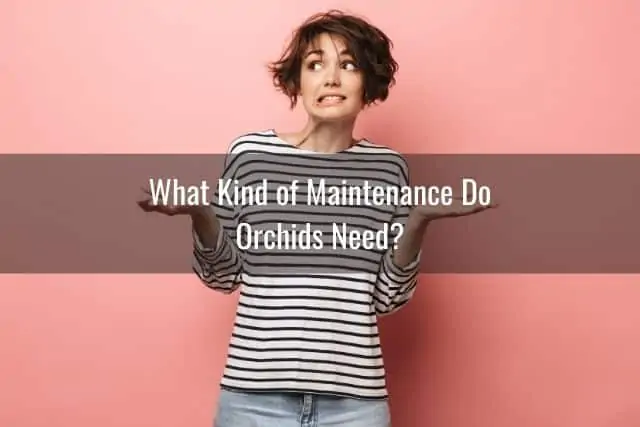
Compared to other houseplants, orchids may require more attention to feeding and watering as they are more sensitive. Additionally, some species require high humidity or many hours of light to thrive. That being said, once you have some experience and the resources to care for orchids, they are not time-consuming or high maintenance.
Basic Care Tips for an Orchid
It is highly recommended that for each orchid you acquire, you research the basic requirements, including:
- The amount of watering that the plant needs is fundamental. Depending on the species, it may prefer damp or dry conditions.
- The lighting for orchids, including intensity and duration. This plays a big role in blooming and general health.
- Orchids are a tropical plant and enjoy humidity in the form of misting or indoor humidifiers.
- The temperature at which these plants thrive is critical. Some orchids even need cooler nights to bloom.
- Depending on what time of the year it is, the fertilizer requirement may change, including frequency and concentration.
Rest Periods of Orchids
Like many plants, orchids go through seasonal rest periods where blooms drop and the flower spike shrivels. This is completely normal, although it may seem at first that your plant is dying.
Novice orchid growers think that the plant is dead once the blooms die, but this is actually not true. After the flowers fall off the orchid, it is simply entering a rest period and before it starts a new growth phase.
As long as your orchid still has healthy green leaves and healthy roots, there is a good chance it can rebloom again. Flower spikes and new blooms will form after several months of inactivity, so it is important to appropriately adjust your plant maintenance.
During this dormant phase, move your orchids to a cooler area with lots of indirect sunlight. As the rest period normally occurs in winter, this is easy to accommodate. Additionally, reduce or stop fertilization to reflect the reduction in nutrient requirements.
An easy way to provide nutrients to your orchid is with the use of water-soluble food. You can use an orchid fertilizer such as Miracle-Gro Orchid Food, which is easy to use and affordable. Apply it every two weeks during periods of active growth. During periods of rest, fertilize every four weeks.
For more information, read more about how to fertilize orchids here.
How Long Do Orchids Live?
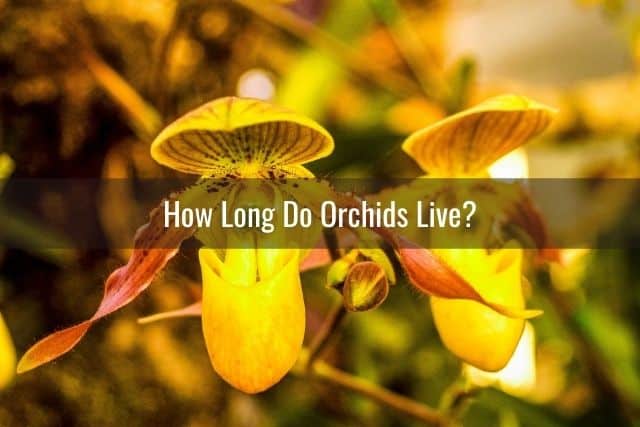
Theoretically, an orchid can live for decades if all of their needs are met, and they do not experience stress or sudden changes. With good care and maintenance, most orchids can be kept as houseplants for many years.
That being said, many people dispose of their orchids after the initial blooming phase. Unfortunately this is because they think these orchids are dead instead of dormant. Do not make this same mistake!
If you are unsure about how to care for your orchid after the blooms are gone, read this guide about what to do with an orchid after the flowers fall off.
The Oldest Orchid Recorded
Thought to be the oldest orchid globally, a 160-year old tiger orchid is located in the Singapore Botanic Gardens. Using old records and photographs, it was found that there were references to this same orchid species in the same location years ago. This UNESCO World Heritage Site is home to a National Orchid Garden, which showcases over 1,000 species of orchids and over 2,000 hybrids.
How To Propagate Orchids
By using a method known as propagation, you can create new plants from your existing orchid. It is inexpensive and relatively easy once you know how to do it. You can propagate an orchid using several methods.
- Using stem cuttings is easy to do but does not work with all species of orchids
- The easiest of propagation methods, division refers to three kinds:
- Pseudobulb division
- Plantlet offshoot division
- Rhizome division
- Active, dormant, and back bulbs are all types of pseudobulbs. These can be used to propagate new orchids, but only a few species produce them
- Only present in a few orchid species including Phalaenopsis orchids, keikis (Hawaiian for “baby” or “little one”) are an easy way to start a new plant
- Seeds, although produced by all species of orchids, are by far the most difficult to propagate. This is because they are rare to source and time consuming to produce
For those that would like to explore propagation with cuttings or keikis, some methods require use of a rooting hormone.
How Long Does It Take for an Orchid To Grow?
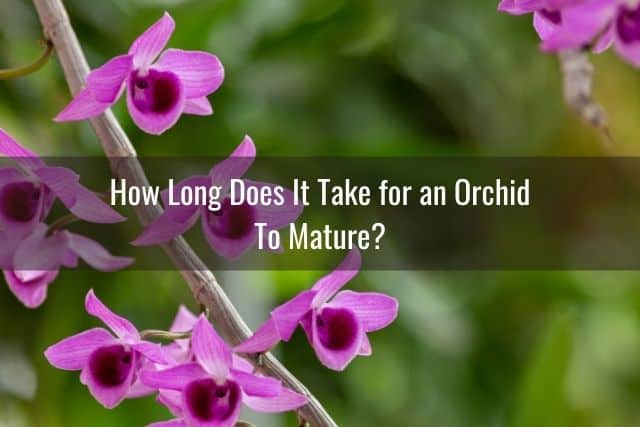
The time it takes for an orchid to mature varies between species and even between flowers. Generally, seedpods take approximately 6-8 months to mature. However, this can also be impacted by external factors. Lighting, humidity, and temperature can influence when and if orchids rebloom and grow.
Life Cycle of a Phalaenopsis Orchid
Like many other flowering plants, the life cycle of a Phalaenopsis orchid is comprised of six stages.
- The production of seeds from a mature plant
- Germination, which is when the plant grows from the seeds
- The formation of the orchid, including root and leaf growth
- The maturation of the plant, when flowers start to form
- The flowering of the orchid, which can take about 3 months for this species
- Initiated by pollination, reproduction then can occur
What Is the Best Medium To Plant My Orchid In?
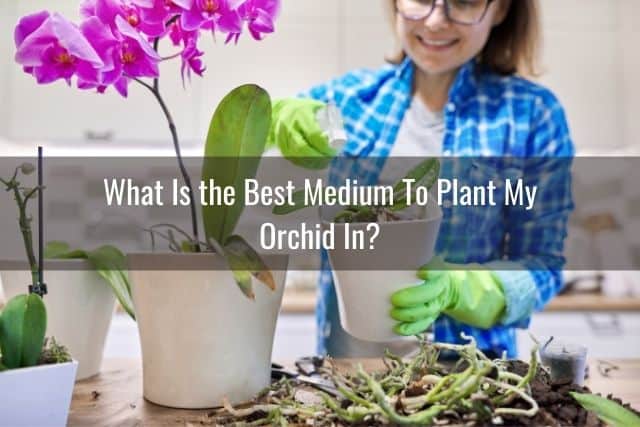
Plant pots and containers come in a variety of styles, materials, designs, and sizes. Additionally, the material used to fill those containers can vary depending on the need of the plant. Orchids need to use pots and orchid potting media specifically designed for them due to their water and aeration requirements.
Proper Pots for Orchids
For orchid plants, the pot must provide aeration and drainage. There are many sizes, materials, and styles to choose from. The most popular type of orchid pot is a transparent, plastic pot, which offers many advantages.
An example of this would be these pots by RepotMe. The slits in the pot allow water to drain and the root system to aerate. In addition, these pots are clear and allow the root system to be easily observed. These plastic pots can also be placed inside a large ceramic pot for decorative purposes.
Another important factor to consider when choosing a pot for your orchid is how easy it will be to repot eventually. Also consider what steps are involved.
An advantage of using thin, plastic pots is that they can be cut away from the plant without harming the root system when it comes time to repot the orchid. I recommend the ELIT Orchid Pots, which provide all of the advantages described above.
Finding the Correct Potting Mix for Orchids
Orchids require a lot of air to surround their roots, especially epiphytic species. It is very important you use orchid specific potting media.
If you use regular potting soil, there is a high chance for root rot and reduced airflow. Many orchid potting media are specifically designed with aeration in mind.
Orchid potting mixes, such as this one by SunBulb, may include bark, horticultural charcoal, peat, perlite, or sphagnum moss.
The best orchid potting medium would be one that is porous, allows water to drain quickly, and is light to promote root aeration. I use an orchid potting mix such as this one by Perfect Plants. It provides drainage, which is essential for orchids.
Regular potting soil is too dense and can easily suffocate the plant, so it is important to pay special attention to the type of potting media you are using for your orchid.
If you would like to use alternatives to orchid potting media, such as mounting your orchid on a tree, or using lava rock, learn more about orchid potting media alternatives here.
Final Thoughts
Although intimidating at first, orchids are easy to maintain once you know the basic requirements for your particular orchid species. Orchids are not hard to grow! They are just different and their nuanced care needs may take some time to get used to.
Water, feeding, humidity, and light are important factors in your plant’s success and longevity. I have gone over the basics of orchid care here. Hopefully it has given you a good place to start.
There are many varieties of orchids, some of which are more challenging than others, and their needs may differ. Caring for this plant species is a rewarding experience. Remember, orchids are not necessarily hard to grow, they are just different. It may take a little time and research as a beginner, but it definitely can be done. Happy orchid growing!
If you enjoyed this article, please pin it and share!
